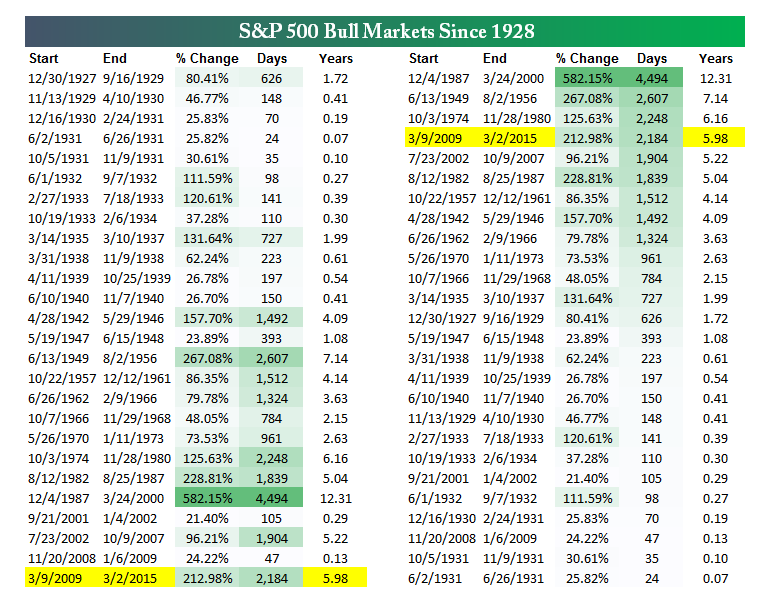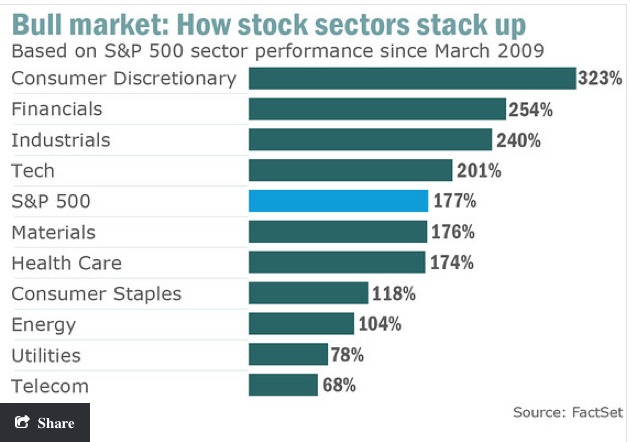Six years ago, investors were in a world of pain.
The American economy had fallen into a steep recession and major US stock indices were off more than 50% from their pre-financial crisis highs of 2007.
A historic bull market has just passed the six-year mark. The US is experiencing robust jobs growth and is in far better shape than the Eurozone and Japan.

Here’s what you need to know about this rally for the record books.
Longevity
Since March 9th, 2009, the S&P 500 Index has gained about 213% (through March 2).
That’s the 4th longest bull market on record, according to Bespoke Investment Group.

If this bull can keep charging for 61 more trading days, it will become the third longest, bypassing the runup in stock prices from 10/3/1974 to 11/28/1980.
Exclusivity
If you look at the 12 bull markets since the end of World War II, this current rally is part of an elite group.
Only half of them made it to a fifth birthday.
Sector Performance
What are the sectors that have really powered the S&P Index 500 over the past six years?
The best performing sectors have been consumer discretionary, financials and industrials, according to data compiled by FactSet.

Retail Investors
Individual investors as a group missed a big chunk of this rally.
In the early years of this bull market, from 2009 through 2013, retail investor participation was low. Mom and pop investors had only piled into stocks in a big way by the summer of 2014.
Apple
Then there’s Apple (AAPL).
The maker of iPads and iPhones has had a very good bull market.
With a market capitalization of $737 billion, Apple (AAPL) is currently the world’s most valuable company.
On March 18, it will replace AT&T (T) as part of the elite 30 blue chips that make up the Dow Jones Industrial Average.
Positive Trends
So does this bull market have staying power heading into the rest of 2015?
On the plus side, the U.S. jobs machine is cranked up. The economy generated 295,000 jobs in February.
That marks the 12th straight month of 200,000-plus new jobs and the best employment run in 20 years.
Risk Factors
The US Federal Reserve is widely expected to start raising interest rates later in the year.
A strong U.S. dollar has hit export earnings and overall American corporate profits are showing signs of faltering.
What to watch
In a recent post, Sam Stovall, chief equity analyst at S&P Capital IQ, points out that while earnings have weakened they’re still in the ballpark of the median average for other bull markets.
Bearish analysts point to the relatively high valuations for stocks, but Stovall isn’t hugely concerned just yet.
As he points out:
“While the S&P 500’s current P/E on trailing 12-month operating of 17.8 is high, relative to the long-term median of 15.0, it may be justified by an inflation rate that is well below the long-term median.”
Takeaway
There’s no denying that this bull market is pretty long in the tooth.
Earnings are weakening by some measures and investors could react negatively to Fed interest rate hikes.
However, this bull market has confounded critics in recent years and has kept charging ahead.
For now, let’s pause to celebrate the six-year mark. It has been quite a ride.
Photo Credit: CJ Sorg via Flickr Creative Commons
The investments discussed are held in client accounts as of March 10, 2015. These investments may or may not be currently held in client accounts. The reader should not assume that any investments identified were or will be profitable or that any investment recommendations or investment decisions we make in the future will be profitable.




